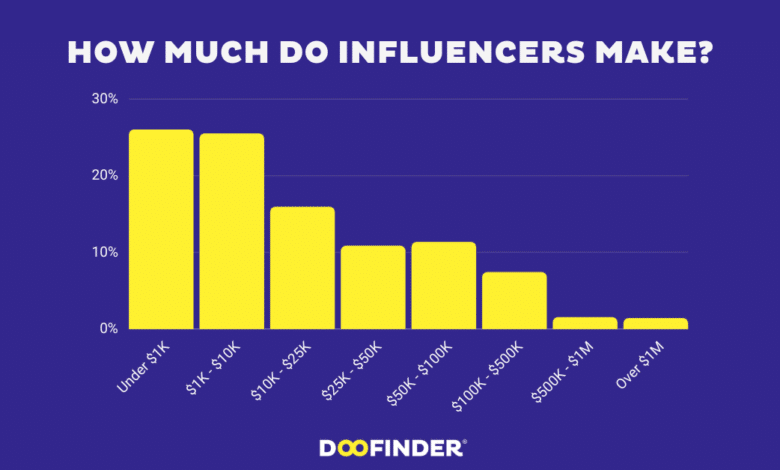
The Influencer Landscape
They often have the ability to sway their audience’s opinions and purchasing decisions. As a result, brands are eager to collaborate with influencers to promote their products or services.
- Macro-Influencers: Possess between 500,000 and 1 million followers.
- Mega-Influencers: Boast over 1 million followers.
Factors Affecting Influencer Earnings
Several factors determine how much influencers can earn. These include their follower count, engagement rate, niche, and the type of content they produce.
1. Follower Count:
The number of followers an influencer has is a crucial factor in determining their earnings. Generally, the more followers an influencer has, the higher their potential income. However, follower count alone doesn’t guarantee higher earnings. Engagement and the quality of the audience are also critical.
2. Engagement Rate:
Engagement rate refers to how actively an influencer’s followers interact with their content. High engagement rates can significantly boost an influencer’s earnings. Brands prefer influencers with high engagement because it indicates that the influencer’s audience is more likely to take action based on their recommendations.
3. Niche:
The niche or industry an influencer operates in can greatly impact their earnings. Influencers in lucrative niches, such as fashion, beauty, and technology, often command higher fees. This is because these industries have higher advertising budgets and more competitive markets.
4. Content Type:
The type of content an influencer produces also affects their income. Influencers who create high-quality, engaging content—whether it’s blog posts, videos, or photos—can attract more brand collaborations and higher fees.
5. Location:
The influencer’s geographical location can influence their earnings. Influencers in countries with higher costs of living, like the United States or Europe, might earn more compared to those in countries with lower costs of living. Additionally, influencers based in global markets might attract international brands, which can further boost their earnings.
How Influencers Make Money
Influencers use various revenue streams to earn money. Here are some of the primary ways influencers monetize their presence:
1. Sponsored Posts:
The payment for sponsored posts can vary widely depending on the influencer’s follower count, engagement rate, and the complexity of the content.
2. Affiliate Marketing:
Affiliate marketing involves promoting products or services and earning a commission on any sales made through the influencer’s referral link. This revenue stream can be lucrative for influencers who have a strong influence over their audience’s purchasing decisions.
3. Product Collaborations:
Many influencers collaborate with brands to create their own line of products. These collaborations can include anything from clothing lines to beauty products. The influencer earns a share of the profits from these products, which can be a significant source of income.
4. Ad Revenue:
Platforms like YouTube offer ad revenue opportunities for influencers. By enabling ads on their videos, influencers can earn money based on views and engagement. YouTube’s Partner Program allows content creators to monetize their videos through ad placements.
5. Merchandise Sales:
This can be a lucrative revenue stream, especially for influencers with a dedicated fan base. Merchandise sales can be a way to capitalize on the influencer’s personal brand and further engage their audience.
6. Subscription Services:
Some influencers use subscription-based platforms like Patreon or OnlyFans to offer exclusive content to their followers. Subscribers pay a monthly fee for access to premium content, which provides influencers with a steady income stream.
Earnings Breakdown
To give you a better understanding of influencer earnings, let’s look at some general figures:
- Micro-Influencers: They can earn anywhere from $100 to $1,000 per sponsored post, depending on their engagement rate and niche.
- Mid-Tier Influencers: These influencers typically earn between $1,000 and $10,000 per sponsored post.
- Macro-Influencers: Earnings for macro-influencers can range from $10,000 to $50,000 per sponsored post.
- Mega-Influencers: With their vast reach, mega-influencers can command $50,000 or more per sponsored post.
These figures are general estimates and can vary widely based on the influencer’s unique situation.
Future Trends in Influencer Earnings
As the influencer industry evolves, several trends may impact influencer earnings:
- Increased Focus on Authenticity: Brands are increasingly seeking influencers who have genuine relationships with their audience. Authenticity can lead to higher engagement and potentially higher earnings for influencers.
- Diversification of Revenue Streams: Influencers are likely to continue diversifying their income sources, exploring new ways to monetize their presence and reach.
- Emergence of New Platforms: As new social media platforms emerge, influencers will have more opportunities to expand their reach and earnings.
Conclusion
In summary, influencers can earn a wide range of incomes based on several factors, including their follower count, engagement rate, niche, and content type. From sponsored posts to affiliate marketing and merchandise sales, influencers have multiple revenue streams at their disposal. As the industry continues to grow and evolve, influencers will find new ways to monetize their influence and engage their audience.
Understanding how much influencers earn provides insight into the economics of social media and the potential opportunities for those looking to build a career in this dynamic field.




